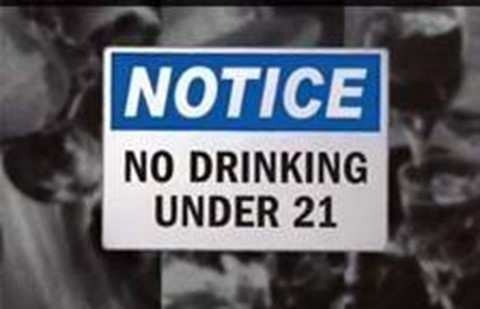The American Minimum Drinking Age Explained

No drinking under 21 sign. (Photo/CDC)
April 4, 2023
The Drinking Age: How did we get here?
April 4, 2023, 2023, 11:59 p.m. EST, Erie Pa. —Turning 18 in the United States grants young adults access to the many wonders of adulthood which were previously out of reach. At this age Americans can register to vote, serve on the front lines of war, get a tattoo without parental consent, get married, and even adopt a child. At the age of 18, you are considered an adult in the eyes of the law, the world is at your fingertips, there really is no threshold they cannot cross—except that of a bar. Until the age of 21, it is illegal for Americans to purchase or consume alcohol. Why is this the case? And how long has it been this way?
To explain the current state of alcohol and the stigma surrounding its consumption, it is best to start from the beginning.
During the creation of the country, according to PBS.com, alcohol was considered healthy. Doctors would prescribe whisky to their patients in order to cure ailments like depression and even cancer. Alcohol was considered a source of strength and digestive aid. At the time, alcoholic beverages were considered as an alternative to water because America had yet to create a standard water treatment system.
“For some people, it was because water was poisonous in the sense that it had all kinds of bacteria they didn’t quite understand,” stated Derek Brown, chief spirits advisor for the National Archives Museum’s “Spirited Republic” in an interview with Colleen Shalby for PBS.
If alcohol was viewed as a medicine at one point and even an alternative to water when did things start to shift?
The tables started to turn in the years 1920 – 1933 when the 18th Amendment had been made to the Constitution. This era was called the Prohibition, in which all manufacturing and sale of alcoholic beverages had been banned in the US.
Even though alcohol was outlawed, the American citizens found ways around the law, popularizing things like “moonshine” or illegal spirits made under the light of the moon, to prevent being caught by law enforcement, according to BelleIsleCraftSpirits.com. The moonshine craft became one of the most profitable businesses in America along with the pop-up of speakeasies, or secret bars where alcohol was illegally sold, according to USA Today.
It is believed that America’s current stance toward alcohol today is a direct effect of the Prohibition and the lucrative attitude that was directed toward alcohol in the 1920s.
But why 21? Where did this number come from?
According to WorldHistory.org, in Medieval England, it was common law that a person did not become an official adult until 21. At this age, person could vote, be granted knighthood and drink as well. This idea was brought over when the Europeans arrived and established the original colonies.
President Franklin Roosevelt in 1932, ended the Prohibition with the 21st Amendment. Since then, alcoholism and alcohol abuse in America has rapidly increased. During Roosevelt ’s presidency, he changed the minimum ages for the draft and for voting from 21 down to 18 with the 26th Amendment. Soon after this, legislators opted for this same energy to be directed to the drinking age.
Then, according to MentalFloss.com, states were put in charge of deciding their own minimum drinking age. Some states opted to change to 18 or 19, while others opted to keep it 21. This resulted in the creation of “blood borders” or borders between states that had a minimum drinking age of 18 while the other was 21, where teens would drive across the border, drink, and sometimes have severe or fatal drunk driving accident, hence the name “blood border”.
The number of fatalities from these drunk driving incidents lead to the enactment of The Minimum Legal Drinking Act of 1984, which made the Minimum Legal Drinking Age (MLDA) 21. According to the Centers for Disease Control and Prevention (CDC), the enactment of this resulted in a 16% decline in motor vehicle crashes in states that raised their drinking age to 21.
This leads us back to the current state of American culture of drinking seen today.
The history of alcohol in America is an evolving story that can be traced back to the creation of the country. Today, the American minimum drinking age is set to 21, and it does not like that will change any time soon.




